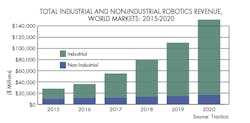The robotics and motion-control markets shattered records in 2017. According the Association for Advancing Automation (A3), both markets set new records for the first nine months of 2017. In the robots field, 27,294 robot orders were placed, equating to approximately $1.473 billion in North America alone. These figures represent a growth of 14% in units and 10% in comparison to the first nine months of 2016.
Orders related to the automotive industry are up 11% in units and 10% in dollars, and non-automotive orders are up 20% in units and 11% dollars. The 25,936 robots shipped in the first nine months of 2017 were valued at $1.496 billion. That is a growth of 18% in units shipped and 13% in dollars in comparison to 2016. Automotive robotic shipments grew 12% in units and 9% in dollars, and non-automotive shipments increased by 32% and 22%, respectively. The industries with the highest robotic presence were metals (54%), automotive components (42%), and food and consumer products (21%).
The outlook from Tractica predicts growth for robotic sales in the industrial and non-industrial markets.
In the motion-control market, shipments increased by 10% to $2.6 billion. This is the highest nine-month mark for the industry since these figures began being tracked. The largest product categories are motors (38% of shipments), actuators and mechanical systems (18% of shipments), and electronic drives (17% of shipments).
The five fastest growing categories in the first nine months of 2017 were motion controllers (24% to $147 million), sensors and feedback devices (20% to $116 million), ac drives (15% to $295 million), actuators and mechanical systems (13% to $479 million), and, lastly, motors (11% to $1 billion). While most distributors feel that orders and shipments will be flat in the next six months, the majority of suppliers believe that order and shipment volumes will actually increase over the same period.
Alex Shikany is the Director of Market Analysis for the Association for Advancing Automation.
Machine Design recently spoke with Alex Shikany, Director of Market Analysis for A3, on what we can expect in the robotics and motion control market for 2018.
Where do you see the robotics and motion-control markets growing in 2018?
The robotics market has grown in just about every industry this year, automotive and non-automotive, but the lion’s share of growth is expected to come from the electronics industry. Still, there are many opportunities emerging in life sciences, warehousing/logistics, and mobile applications, while the automotive industry is expected to remain the largest industry for robotics in the near term. The motion-control market is much broader, and will benefit from continued increases in food/consumer goods, warehousing, pharmaceuticals, and the growing demand for factory automation.
What specific products or technology will see growth due to the rise of robotics?
Collaborative technologies that allow robots to work side by side with humans will continue to proliferate in the market. Sensors and related technologies that make these systems possible are also expected to increase. Mobile platforms that allow robots to navigate complex environments will continue to be of interest to customers in certain industries.
What are the biggest obstacles the robotics or motion-control market needs to overcome over the next few years (for example, customer adoption, security, accuracy, max load, etc.)?
New customers must realize that risk assessments are necessary in just about every circumstance when installing robotics. This could potentially be a hurdle to new customers entering this industry who are inexperienced with the technology. RIA’s [Robotic Industries Association] standards development activities are designed to grow awareness of this issue and help provide useful information and standards that are necessary to bridge this gap.
Cybersecurity is also a growing concern, as robotics, motion control, and related automation technologies are connected via the cloud. This can and likely will lead to a sizable market opportunity in cybersecurity as it relates to automation markets.
What changes should engineers expect for 2018 and beyond (for example, the need for more education; changes in tasks; customer demands; increased robot use, etc.)?
The market will continue to demand robust resources for education and training as these technologies continue to provide more value. Machine vision is playing an increasingly crucial role in successfully designing intelligent automation systems, and we’re seeing it used more in concert with robotics and motion control. As a result, we are seeing an increase in demand for our AIA Certified Vision Professional program from engineers all across the globe. Furthermore, RIA, AIA, and MCMA provide a wealth of articles, certification programs, events, and online videos to help customers become versed in these various technologies. These resources can be accessed by vising our website www.a3automate.org.



